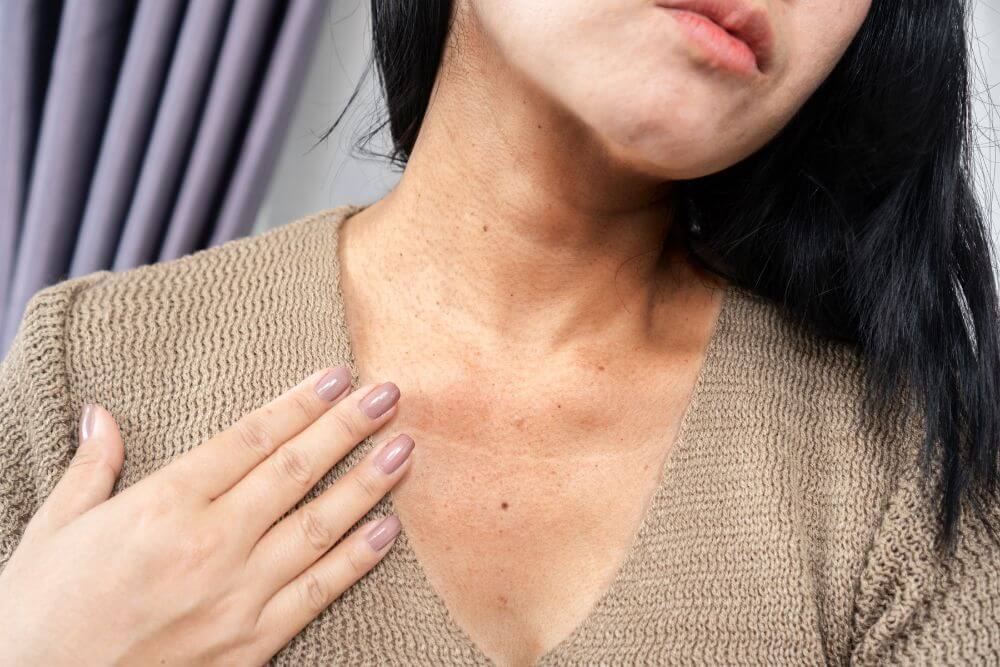Clearing the Itch: Understanding Diabetes Skin Rashes
Diabetes is a complex metabolic disorder that affects millions of individuals worldwide. Beyond its impact on blood sugar levels, diabetes can significantly influence various aspects of health, including skin wellness. Skin conditions are prevalent among individuals with diabetes, often serving as visible indicators of underlying health issues.
In this article you will learn:
What Causes Diabetes Skin Rashes?
The development of diabetes skin rashes is multifactorial, with several underlying mechanisms at play. High blood sugar levels, a key component of diabetes, can impair the skin’s ability to function optimally, leading to dryness, itching, and susceptibility to infections. Neuropathy, a common complication of diabetes, further exacerbates skin issues by diminishing nerve sensation and blood flow to the skin (1).
Moreover, individuals with diabetes often experience compromised immune function, rendering them more susceptible to bacterial, fungal, and viral infections. Poorly controlled diabetes also contributes to inflammation and oxidative stress, exacerbating skin damage and impairing its ability to heal.
What are the Types of Diabetes Skin Rash?
Diabetes can manifest in various skin disorders, each with its own set of symptoms and characteristics. One common condition is diabetic dermopathy, also known as shin spots or pigmented pretibial patches. This is one of the most prevalent skin conditions affecting individuals with diabetes mellitus. Although relatively harmless, diabetic dermopathy can be concerning due to its resemblance to other dermatological conditions due to its small, brown coloured patches on the skin (2). These lesions often resolve on their own over time, however can be an indicator for individuals to maintain good glycaemic control and adhere to proper skincare practices to prevent complications and promote skin health.
Acanthosis nigricans is a dermatological condition which can often be associated with underlying health conditions, such as insulin resistance. The condition is characterised by dark, velvety patches of skin, typically found in body folds and creases such as the neck, armpits, groin, and under the breasts. These patches may feel thicker than surrounding skin and can range in colour from tan to dark brown or black. While the exact mechanism of Acanthosis nigricans development is not fully understood, it is believed to result from the overgrowth and thickening of skin cells in response to insulin stimulation (3). Treatment of Acanthosis nigricans focuses on addressing the underlying causes, such as improving insulin sensitivity.
Other diabetes skin rashes include diabetic blisters, which appear as fluid-filled sacs on the hands, feet, and legs, and fungal infections like candidiasis and ringworm. These rashes thrive in warm, moist environments and can cause itching, redness, and discomfort if left untreated.
What are the Symptoms of Diabetes Skin Rash?
Recognising the symptoms of diabetes skin rashes is essential for prompt diagnosis and treatment. Common signs include itching, redness, dryness, and the presence of lesions or sores (1). In some cases, individuals may also experience numbness or tingling due to nerve damage.
Healthcare professionals diagnose diabetes skin rashes through physical examination, medical history review, and, if necessary, skin biopsies or laboratory tests. Early detection allows for timely intervention and reduces the risk of complications such as secondary infections and skin breakdown.
How do you Treat Diabetes Skin Rash?
Treatment strategies for diabetes skin rashes aim to alleviate symptoms, prevent complications, and promote skin healing. Topical creams containing corticosteroids or antifungal agents may be prescribed to reduce inflammation and combat infections. Oral medications, such as antihistamines or antibiotics, may be necessary for more severe cases (1).
In addition to medication, adopting proper skincare practices is crucial for managing diabetes skin rashes. This includes keeping the skin clean and moisturised, avoiding harsh chemicals or irritants, and wearing loose-fitting, breathable clothing. Maintaining good blood sugar control through diet, exercise, and medication is also essential for minimising skin complications.
How to Prevent Diabetes Skin Rash?
Preventing diabetes skin rashes begins with proactive self-care and disease management. Keeping blood sugar levels within target range through regular monitoring and adherence to prescribed medications can help prevent skin complications. Practising good hygiene, such as daily bathing with mild soap and regular moisturising, can also reduce the risk of infections and skin dryness (1).
Additionally, individuals with diabetes should inspect their skin regularly for any changes or abnormalities, such as cuts, wounds, or new rashes. Seeking prompt medical attention for any concerning symptoms can prevent minor issues from escalating into more significant problems.
Conclusion
Diabetes skin rashes are common but manageable. By recognising the signs early and managing your blood sugar alongside daily skin care, you can reduce irritation, prevent infections, and protect your skin health long term.
What This Means for You
Small daily habits—like moisturising, choosing breathable fabrics, and managing blood sugar—can make a big difference. You don’t have to live with constant skin discomfort.
Ready to Feel Better in Your Skin?

